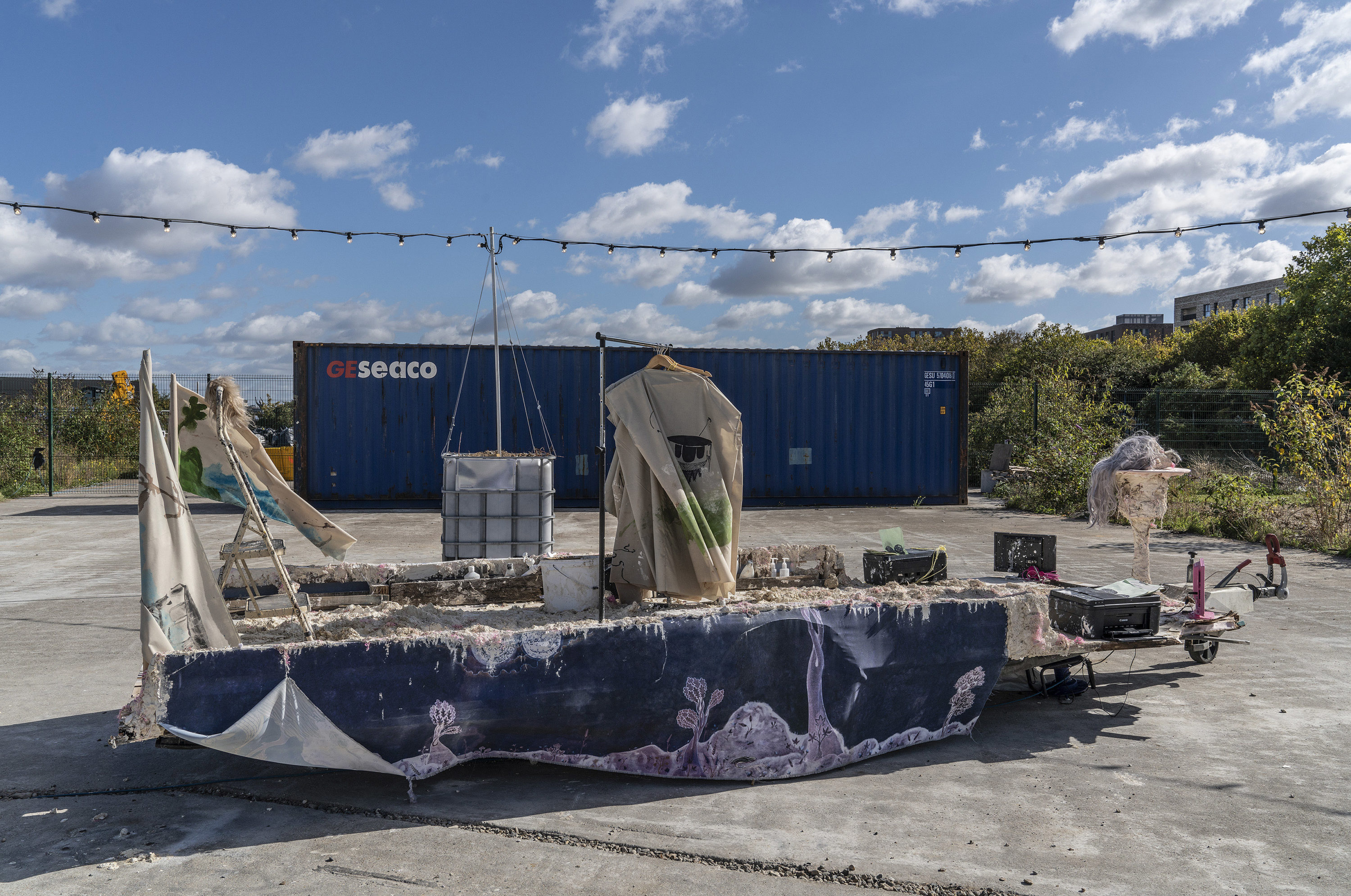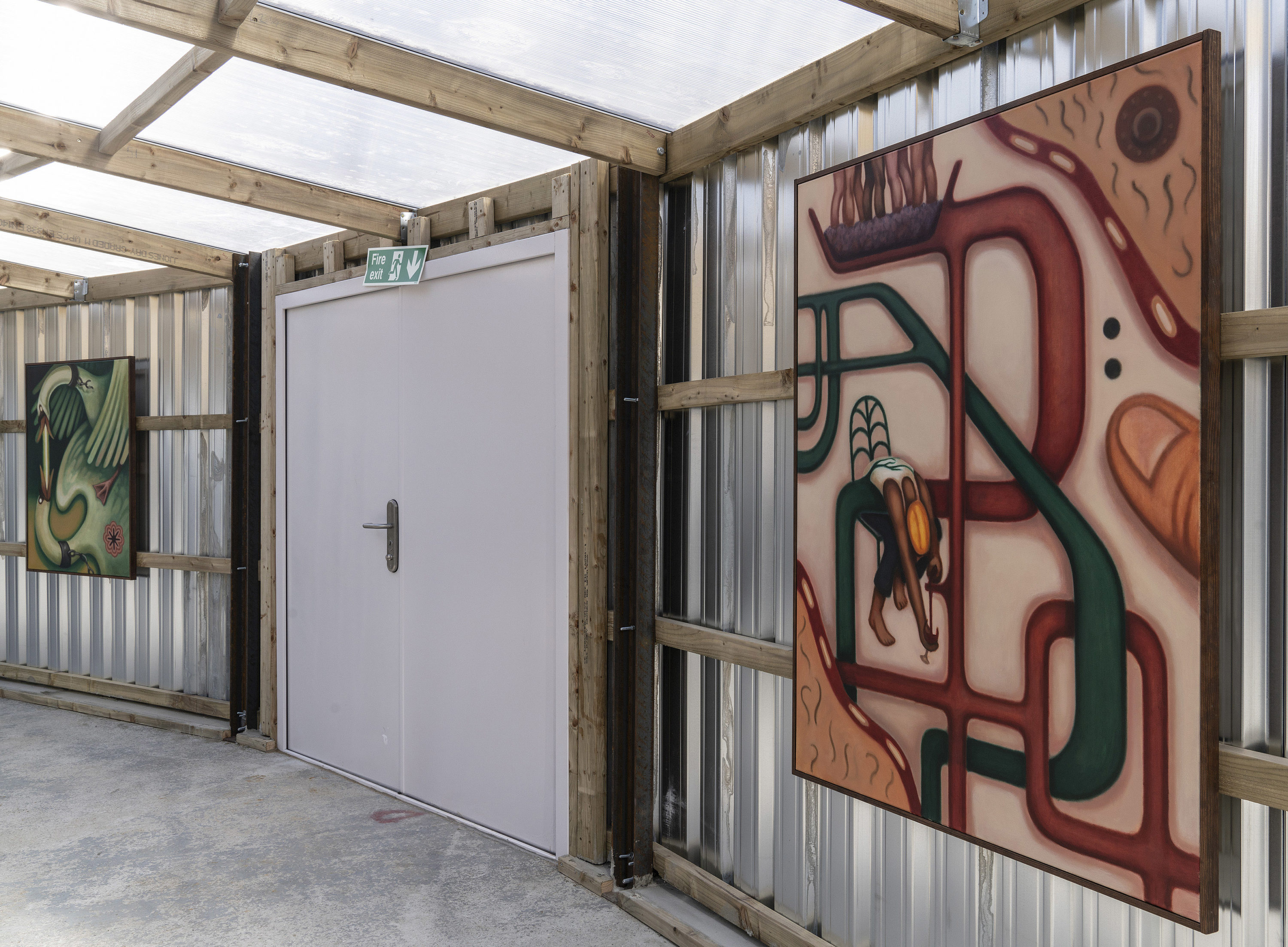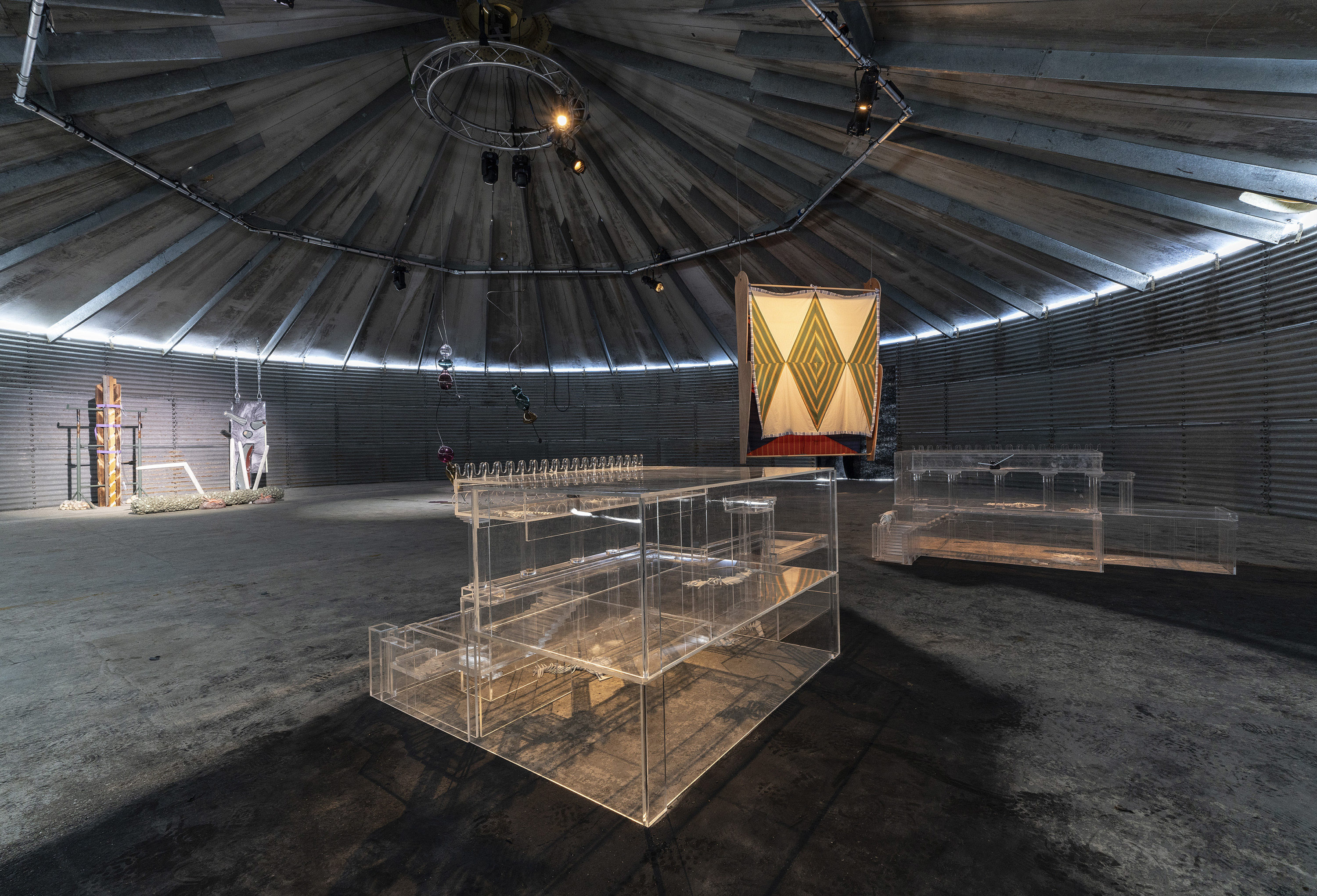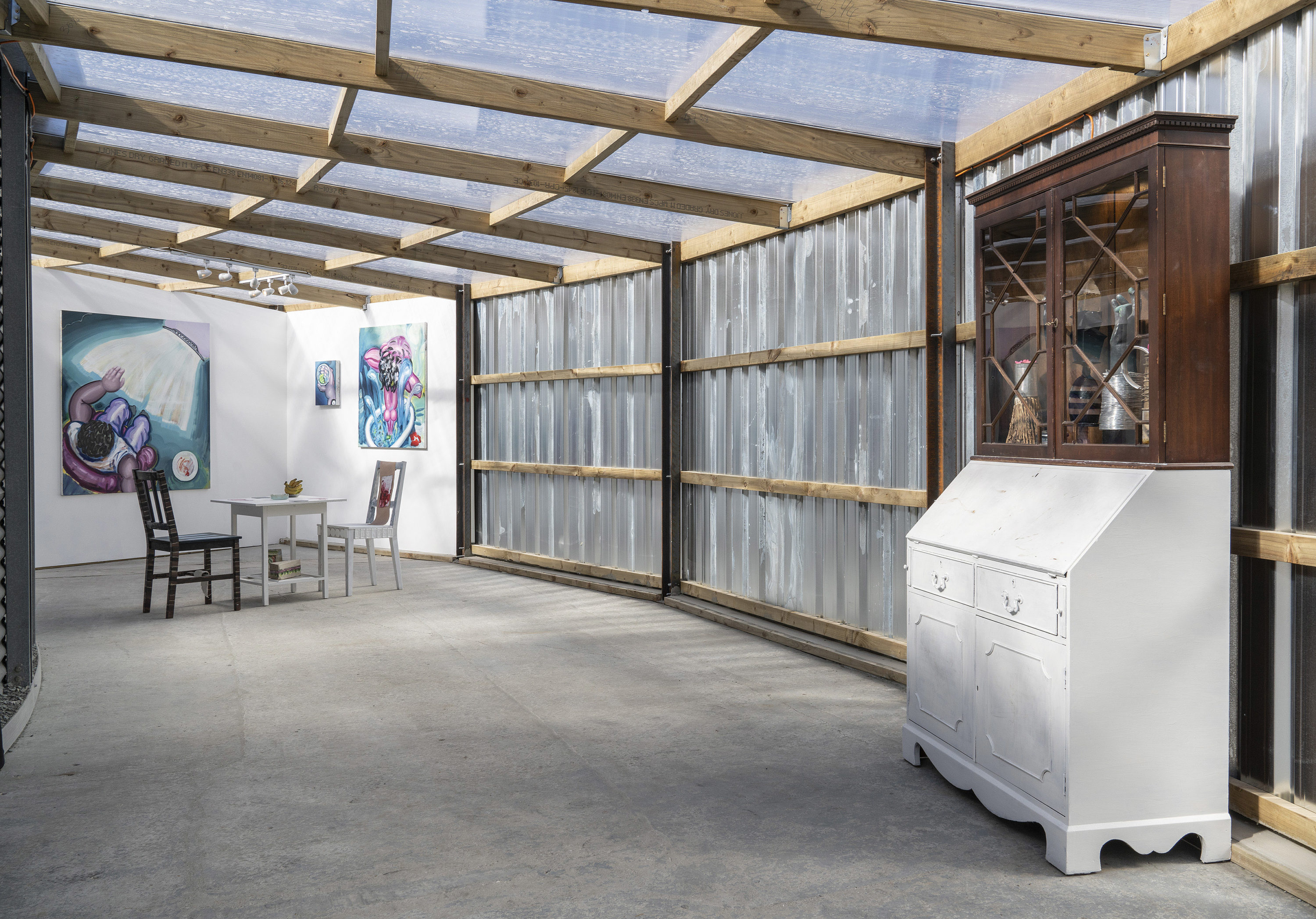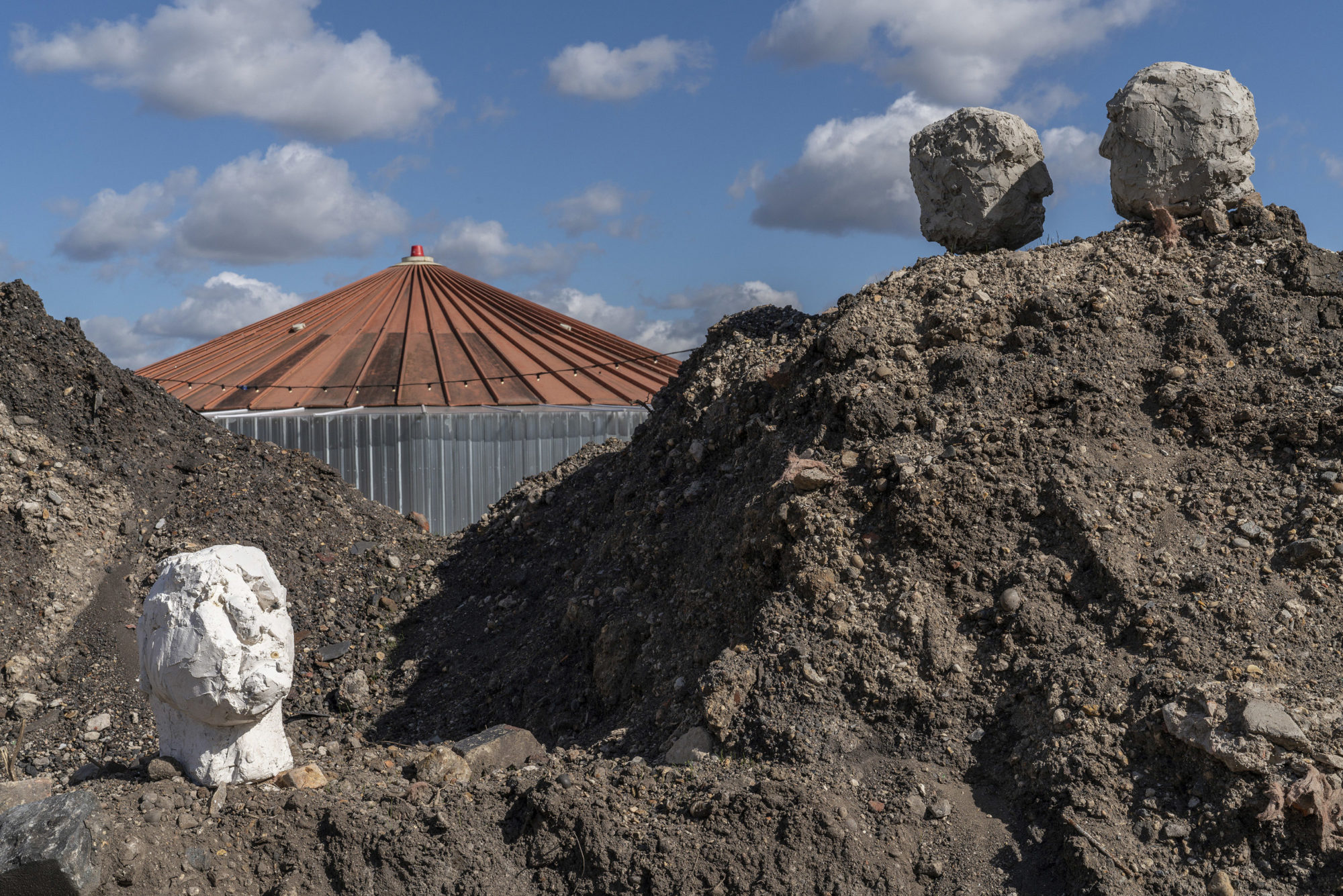New Frontiers
Hannah Bays, Jacob Farrell and Luke Overin, Young London, installation view, 2018 [photo: Noah Da Costa; courtesy of V22 Silvertown Studios, London, England]
Share:
In summer 1967, architectural critic Reyner Banham was sightseeing in the east end of London: “the given landscape is wide, raw, flat and sandy under the expanse of sky that would make poets rave if it wasn’t the southern end of Hackney marshes.”1 His view was over the Stratford shipping terminal, part of a new breed of site created by the containerization that was transforming global industry. Banham, a British urbanite, admired Los Angeles and saw the freshly tarmacked ports of stacked containers as the new sublime. He declared the Stratford terminal as “one of the great sights of London.”2 Today, the view from where he stood reveals a very different kind of sublime. The terminal and adjacent dumps were remade into the site of the 2012 London Olympics and rechristened as the “East Village,” with dozens of apartment blocks. By 2020 it is slated to become the site of a new “culture district” that will include branches of the Victoria and Albert Museum, Sadler’s Wells Theatre, the London College of Fashion, and the Slade School of Art.
Carl Gent, Young London, installation view, 2018 [photo: Noah Da Costa; courtesy of V22 Silvertown Studios, London, England]
One of 26 works of art commissioned for the 2012 Olympics is Monica Bonvicini’s RUN (2012). The word is spelled out in staggered, 30-foot-tall reflective letters next to a road that cuts through the area. Whereas the sculpture might have been a feel-good cheer on to the games, the word now seems more like a warning shout that wasn’t heeded, a cry to escape the impending wave of property development and raised rent costs that would follow. Other artworks created for the games have been recently incorporated into “The Line,” an extended art walk of about a dozen outdoor sculptures—its contents changing every two years—that runs from the former Olympic site to the Millennium Dome. A bit less than three miles south, on a peninsula just across the Thames, the dome is located in an area still attempting to rebrand itself after a dubious, overblown rebranding for the turn of the new century. There are several other official artwork trails that we could follow—ones with works commissioned from such artists as Nathan Coley, Lucy Skaer, and Ruth Ewan and intended, as part of the Tideway sewage works, to “activate” sites along the Thames; or with works by Richard Wright or Spencer Finch that will embellish the new train stations along the cross-city Elizabeth line opening next year (a preview exhibition of artists commissioned was appropriately titled Art Capital).
These physical artworks, though, are only the visible tip of the iceberg. We might follow another line for a more accurate depiction of London’s much-touted “creative scene.” This one follows the establishment of artist studios as part of new property developments. It runs from Shoreditch, an area transformed in part through artists in the 1990s, eastward to Silvertown, an outcropping that holds the Tate & Lyle sugar refining factory, London City Airport, several former industrial buildings, and what seems to be considered a negligible amount of current residents. The area was explicitly marked out in the London mayor’s recently drafted Culture Strategy to be developed as a “creative cluster,” with a container-complex of artist studios launched in September 2018. Silvertown is part of the borough of Newham, one of London’s wealthiest councils. The area is also currently undergoing a housing crisis that is forcing many families out of rent-subsidized housing to areas outside London. Meanwhile, next to the new studios, construction is under way for Royal Wharf, an Asian property developer’s massive complex of luxury apartments.
Artists have long been labeled as foot soldiers of gentrification, or at the least as indicators of the changing tides of an area, but now the artist’s role in the processes of planning, development, and regeneration is codified and formalized as standard practice. The story in London perhaps mirrors that in other large cities, and it might serve as a warning to efforts in other places: what began as an informal process of exploiting empty and rundown spaces has transformed into a multi-billion-pound property market and a struggle for artists to afford studios, much less places to live, anywhere in the city. SPACE, one of the city’s main artist studio coordinators, started in 1968 by getting permission from the Greater London Council to use an empty warehouse covered in pigeon shit at St. Katherine Docks for two years. In the 1960s, it seems, it was unimaginable that the derelict post-industrial wastelands might be reborn into something profitable. St. Katherine now holds apartments that date back to the 90s. If Stratford’s depot and “fridge mountain” dump site can be transformed into a mini-city with its own mall and museums, then all those old, quiet neighborhoods and fringe areas of the city, and beyond, warrant being eyed anew.
Justin Fitzpatrick,Young London, installation view, 2018 [photo: Noah Da Costa; courtesy of V22 Silvertown Studios, London, England]
In “No Room to Move,” an article written by Josephine Berry Slater and Anthony Iles for Mute in 2009, the authors chart the increasing coordination of UK developers with “creatives” as the instruments of regeneration. This concept of regeneration, wherein artists are used as a model active community, only ends up replacing what was there already: “Community is killed off only to be ‘regenerated’ in zombielike form, a living dead state of social (non)reproduction and officially orchestrated sham spectacles of being together.”3 The artist initiatives of the 60s and 70s had already been coopted into marketing modes and not-quite-subconscious means of control: “the aestheticisation of space reveals that the powers that be must choose their mode of address more carefully than ever before. Control must deploy the veneer of health and happiness to get things done. Or, in Foucauldian terms, governmentality uses aesthetics to penetrate the subject more deeply, to tap into our capacity for self-government.”
The article, written at the onset of post-2008 depression austerity tactics, with a (nominally liberal) Labour government still in power and Conservative Boris Johnson just taking the post of London’s mayor (with a tactic of giving private developers green lights for practically everything), captures a peculiar moment. Berry and Iles’ cynicism here seems almost cute, as they talk of “tracts of unsold newbuild flats whose ‘luxury apartment’ banners flap forlornly in the wind.” The neoliberal city has only become even more trenchantly so: austerity continues, though by now plainly as a tactic of business owners to maintain profits at the expense of public services, and those flats might still be empty, but many are sold, picked up by investors from Russia, Saudi Arabia, and China. London as a creative capital is rife with shared workspace-cafés opening monthly, even as small venues and informal spaces are regularly closed or demolished.
Diego Delas, Sebastian Jefford, Leonor Serrano Rivas and Isabelle Zhizhi Southwood, Young London, Installation view, 2018 [photo: Noah Da Costa; courtesy of V22 Silvertown Studios, London, England]
In an attempt to salvage the situation, the current mayor, Sadiq Khan, has launched a charm offensive, pushing the positives of trying to keep artists from fleeing the city. “The city’s creative economy now employs 1 in 6 Londoners and contributes £47 billion to the economy” 4 his office’s Cultural Strategy declares in its introduction. His current strategy includes setting up a system of micro-grants for arts organizations and designates at least three “cultural quarters” that would supposedly hold cultural institutions and “affordable studios.” It looks positive on paper. Hackney Wick, one area shortlisted to be such a quarter, is currently a hotbed of construction, with new apartment blocks named after the factories that they’ve replaced. Existing studios there have already closed, or they’ve doubled their rent in recent years. Cell Project Space opened new studios with a grant from the mayor’s office last year—but with only five years’ lease on the building. “Affordable” is also a term loosely defined. The studio organizations working with the mayor’s office on pricing policy are ones that already charge rents most artists can’t afford. Other, less messy “creatives,” such as television producers and start-up app designers, however, can. Which is to say, if Hackney Wick is anything to go by, any cultural quarter will be a showcase of creativity that excludes artists.
On either side of Hackney Wick are examples of the current form of studio initiative: Matchmakers Wharf, a mixed-used development, opened in 2012 with retail, 200-plus homes, and 49 studios owned by Acme Studios. Studio providers here became part of the means of funding such projects. This model has proved popular with similar developments planned throughout the city, such as those arebyte has recently opened on London City Island. Dozens of buildings have risen over the past few months on an outcropping of land that sat dormant for more than a decade, near the Millennium Dome. Other newly built apartment blocks have included artists’ studios as a sort of bait for prospective buyers, often sitting empty for months before becoming shared “hot desk” work spaces. What emerges is a sort of doubled reality: while artists are effectively shifted out to the next affordable neighborhood, the caricatured ghost of their labor remains behind to be used to upsell the image of an area to a global elite indifferent to the actuality of any location. We are arriving at the logical conclusion of corporatized arts policies: cultural regeneration without artists, cultural policy without culture.
John Costi and Hannah Bays, Young London, installation view, 2018 [photo: Noah Da Costa; courtesy of V22 Silvertown Studios, London, England]
Despite this inexorable drive for profit and the related interminable pessimism, it’s also important to consider where this process places artists and how it influences artistic practice. The rise and continued onset of business models being applied to arts organizations and art schools since the 90s has led to artist-run projects—and artists themselves—running on the same principles. The widespread occurrence of bureaucratic and corporate-occupation strategies in artistic practices is symptomatic of this shift (just think of the current plethora of artist-business groups like DIS, K-HOLE, or MadeIn Company, or the occupations of Andrea Fraser or Pilvi Takala as ready examples). Inherent in these practices are the optimism of shared civic values and the idea that art might contaminate business to the same extent business has contaminated art, but the feeling doesn’t seem to be mutual. New developments have given up on the pretense of public space, letting the illusion drop for its true existence as investment space, profit space. And perhaps at some point we need to ask, once again, if the master’s tools can dismantle the master’s house. Short-term, undocumentable, senseless gestures feel like the only coherent response to such a situation.
As developers strike ground farther and farther out, beyond Silvertown, to Thamesmead and into Essex, aiming to turn even the quietest housing estate into a “buzzing hub,” what’s most notable about this recent strain of cultural regeneration is that it is unabashedly top-down, guided by wealth-driven priorities. Continuing to build luxury flats with concomitant cultural endeavors nearby makes it plain to anyone living in the city’s less “trendy” areas, or to anyone who feels excluded from the arts: this isn’t for you, it was never for you. Are bottom-up endeavors even possible at this point in urban cultural development? In physical terms, the new ground level means something either beyond developers’ grasp (i.e., property already owned and used, with rent control in place, ideally as policy not choice) or entirely unimaginable to their use (i.e., nowhere). Are property owners who are willing to permanently designate and support sites as studios, galleries, and so forth the only answer?
Benjamin Orlow, Young London, installation view, 2018 [photo: Noah Da Costa; courtesy of V22 Silvertown Studios, London, England]
Perhaps the world’s metropolitan art cities—Berlin, London, New York, Tokyo—are simply already lost, too entrenched and implicated in forces turning them into places designed only for an effective monoculture of elite tourist hot-deskers. All that might remain is for capital to follow those who have left (in the UK, for places such as Margate, Nottingham, Norwich, Frome) to attempt to transform these smaller towns and cities into their own buzzing centers. Maybe, in finally achieving such dizzyingly complex property portfolios, the developers might forget about the “underdeveloped” peripheries, to allow a space where artists might evolve their infrastructure, unabashedly unprofitably. But for that to happen, today’s artists will first have to give up on capital, to shape their own independent and temporary working spaces, unions, and ethics of commerce in and through their practices.
Chris Fite-Wassilak is a writer and critic based in London. He is currently working on a book for Copy Press’ Common Intellectual series.
References
| ↑1 | Reyner Banham, “Flatscape With Containers,” New Society 255 (August 17, 1967): 232. |
|---|---|
| ↑2 | Ibid. |
| ↑3 | Josephine Berry Slater and Anthony Iles, “No Room to Move,” Mute, November 24, 2009, www.metamute.org/editorial/articles/no-room-to-move-radical-art-and-regenerate-city |
| ↑4 | Mayor of London, “Culture for All Londoners: The Mayor’s Draft Cultural Strategy,” March 2018, https://www.london.gov.uk/sites/default/files/2017_draft_strategies_culture_2.0_exec_summary.pdf |
